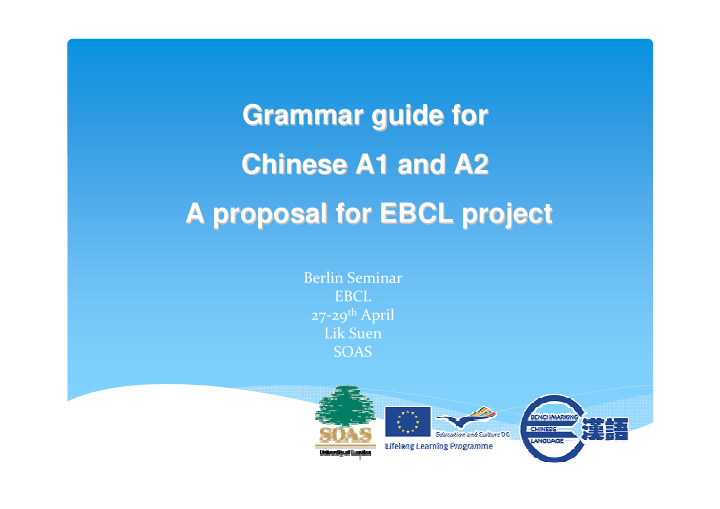



Grammar guide for Grammar guide for Chinese A1 and A2 Chinese A1 and A2 A proposal for EBCL project A proposal for EBCL project Berlin Seminar EBCL 27-29 th April Lik Suen SOAS 1
CEFR ∗ Provides proficiency descriptions for each level. ∗ Like constructing a building , from simple tent (A1) to a luxury castle ( C2) ∗ Tent- Shed- Bungalow -House - Mansion -Castle
CEFR ∗ Provides descriptions of applications of a language ∗ Language can be used for different purposes, for travel, for work, for education, etc. ∗ Like a building, it can be used for different functions, such as ∗ Home - School- Hospital -Stadium
How to learn a language ∗ To construct a building, ∗ To construct a building, you need you also need ∗ Building materials: ∗ Architecture blueprint cement, bricks, tiles… To learn a language, you ∗ To learn a language, you need ∗ Vocabulary need ∗ Grammar 4
Every building is different… How to guide a foreign builder (language learner) to construct a Chinese building (Chinese language)? ∗ Get familiar with building ∗ Get familiar with Chinese materials i.e. regulations and rules of ∗ Vocabulary building i.e. ∗ Grammar and Structures 5
Data ∗ The Chinese framework ∗ UK syllabus
Old Style Grammar Teaching ∗ Thorough ∗ Comprehensive ∗ Detailed ∗ Knowledge based ∗ Academic ∗ Theoretical 7
Communicative based ∗ Interactive ∗ Functional ∗ Efficient ∗ Selective ∗ Focus on differences between mother tongue and Chinese 8
Sources available 中国 ∗ 国内出版物的语法大纲 ∗ 汉语教科书( 1964 ) ∗ 基础汉语 (1971) ∗ 汉语课本 ( 1977 ) ∗ 基础汉语课本 ( 1980 ) ∗ 实用汉语课本( 1980 ) ∗ 初级汉语课本 ( 1994 ) ∗ 现代汉语教程 读写课本 ( 1988 ) ∗ 汉语初级教程 ( 1989 ) ∗ 新汉语教程 – 情景功能结构 ( 1995 ) ∗ 汉语水平等级标准和等级大纲 ( 1988 ) ∗ 汉语水平等级标准与语法等级大纲 ( 1996 ) ∗ 国际汉语教学通用课程大纲( 2008 ) ∗ 新汉语水平考试 1-6 级 ( 2009 ) 9
Sources available 台湾 ∗ 台湾华语文能力测试( TOP , TOCFL 2012) 10
Sources available 欧洲 ∗ 法国教育部中学汉语教学大纲 ∗ 英国考试局的测试大纲 ∗ Edexcel GCSE key grammar ∗ NVQ A1 equivalent to GCSE grade D ∗ A2 equivalent to GCSE grades C to A*
How to identify key grammar points ∗ High frequency in language activities ∗ High frequency in learner’s mother tongue ∗ High frequency in Chinese language activities ∗ Difference between the mother tongue and Chinese ∗ Same (easy) ∗ Very different (difficult) ∗ Similar with slight difference ( more difficult) 12
Complexity of grammar structure ∗ Complexity of a grammar structure is not the key priority in deciding when to teach the grammar. Communicative needs are more important. ∗ Difficult structures with high frequency may be introduced as fixed expressions at A1 level. ∗ Break down the complicated structure into different levels and only introduce the most used functions at A1 and A2 level 13
Key grammar difference A1 ( examples) ∗ 量词 ∗ 副词的用法:也 都 ∗ 形容词谓语句 ∗ 简单比较句 ∗ 人称代词和指示代词(定冠词) ∗ 语序 ∗ 数字 ∗ 了 ∗ 时间 (时点,日期) ∗ 固定结构 / 表达 ∗ 复数后缀 ‘ 们 ’ ∗ 的 ∗ 疑问句 (吗,特殊疑问句) ∗ 否定式 ∗ 能愿动词: 能,想,要 ∗ 两 ∗ 和 14
Key grammar difference A2 ( examples ) ∗ 扩展 A1 的语法项目 ∗ 选择问句 还是 (或者) ∗ 的 ∗ 能愿动词 ∗ 时态助词 ∗ VC ∗ 强调句 是 … 的, 连 … 都 , 什么都 … 15
Further work ∗ Extend and complete grammar difference list for A1 and A2. ∗ Localized: identify grammar differences in a particular language, i.e. German, French, Italian etc. ∗ Cross check with other published frameworks of textbooks and tests/exams ∗ Coding/labelling/grouping in a systematic way to ∗ Provide support and guidance to descriptors ∗ Build up A1 A2 profile 16
Recommend
More recommend